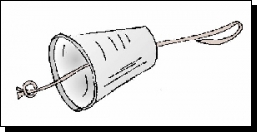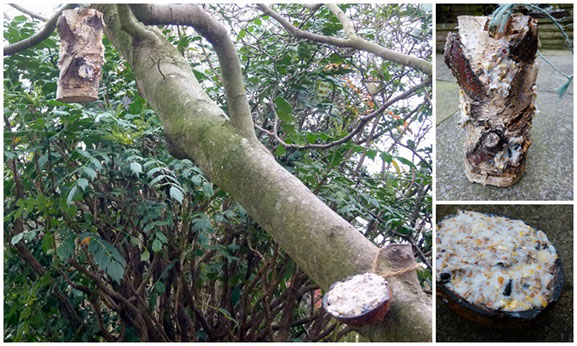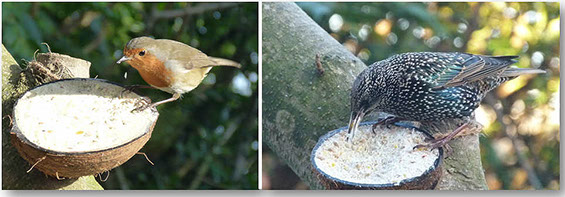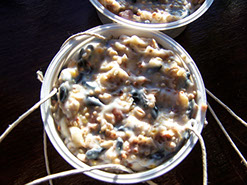

Home
About Us
Allotments
Garden Equipment
Seed Suppliers
Manure Problems
Children's Pages
GLA Blog
Weather Blog
School Veg Patch
Useful Links
Making Bird Cake
You can make various kinds of winter treats to help the birds through the cold winter when food is scarce. Different types of birds feed in different ways. Blue tits will cling upside down, sparrows will cling to hanging containers, robins will visit bird tables and blackbirds like to feed on the ground or bird table. If you want to provide them all with treats them you will need to create some treats to hang in trees, some to put on a bird table and others to place on the ground or on low feeding tables.
What sort of container do you want to make?
To create a hanging container suitable for blue tits:
 Children - Ask an adult to help you
Children - Ask an adult to help you
Make a hole in the bottom of a yoghurt pot.
Tie a knot on one end of a piece of string.
Push the other end of the string up inside of the yoghurt pot and through the hole in the bottom.
When it has been filled you can then hang the pot up like a bell.
To create a hanging container suitable for sparrows:

Children - Ask an adult to help you
Make about four holes along the rim of the margarine tub.
Tie a knot on one end of each of four pieces of string.
Push the other ends of each piece of string through the holes.
Tie the loose pieces of string together over the top of the margarine tub.
Hang the tub from a branch so the birds can sit on top and eat the cake.
Use a container suitable for blackbirds and robins:
Use a margarine tub as above but without the string
Place the tub on the bird table or the ground.
To make a bird cake lollipop:
For this idea you will need a yoghurt pot and a piece of stick longer than the depth of your yoghurt pot. Fill the yoghurt pot with the seed mixture. Push the stick down into the mixture. Put in the fridge to set. When the mixture has hardened, break the pot away. Tie a piece of string around the stick and hang from a tree. You need plenty of fat to stop the mixture falling apart.
Fats and food to use or avoid:
Children - Ask an adult to help you if you are using melted fat or better still use the creaming method below.
Use hard fat such as lard or suet. Unlike humans, birds need high levels of saturated fat. Don't use margarines or other spread type fats. Soft fats can end up smeared on beaks and feathers which can cause the bird harm, Don’t use fat that has been left over from cooking meat either.
A mixture of some of the following just choose a selection, (don’t use stale or mouldy food though as these can cause disease):
- Biscuit or cake crumbs
- Nuts (not salted peanuts, salt is bad for birds). DON’T USE PEANUTS IF YOU ARE ALLERGIC TO THEM.
- Grated cheese (mild cheese)
- Sultanas or raisins
- Chopped hard fruit - apple or pear
- Bacon rind (not from salty or smoked bacon and not chopped into very small pieces that the bird may swallow hole)
- Mixed bird seed
- Chopped suet
- Oatmeal
- Cooked or uncooked rice
- Mashed potato
- Pastry dough
- Chopped cooked pasta
- Dry cereal such as muesli.
- Peanuts whole or chopped (don’t feed peanuts in net bags)
- If you are brave enough you could add dried mealworms!
Don’t use dried or desiccated coconut or very dry bread.
Creaming - no melting method:
This method is safer for children as no heat is involved.
- Leave the block of lard at room temperature for a while to soften.
- Work to soften the lard by creaming with a wooden spoon or use your hand to break up the block and squeeze it into a paste consistency.
- Add the available dry ingredients working with a wooden spoon or hands.
- When the dry mix is fully incorporated, press the mixture into whatever container you are using or just shape the mixture into ball shapes.
- You can also press the mixture into holes that have been drilled into sections on tree trunk.

Melted Fat method:
Children - Ask an adult to help you
Method 1:
Equipment needed:
- Your chosen container
- A saucepan
- A mixing bowl
- A large spoon
- Melt the fat over a low heat until if is runny (DO NOT do this on your own - get an adult to help).
- Mix all your dry ingredients together in a bowl,
- Pour over the melted fat and mix so the dry ingredients are well coated.
- Spoon the mixture into the yoghurt pot or other container.
- Press the mixture down hard to make the mixture into a solid block
- Place the container in the fridge for a couple of hours to harden the fat.

Method 2:
Equipment needed:
- Your chosen container
- A saucepan
- Two mixing bowls
- A large spoon
- Soften the fat by warming it but don’t let it melt
- Let it cool so that it can be handled.
- Whilst the fat is cooling slightly mix up the dry ingredients in a bowl
- Chop the fat up into small chunks and put it in a different bowl.
- Add all your dry ingredients a little at a time.
- Use your hands to squeeze and mix the fat and dry ingredients together.
- Keep adding the dry ingredients until it squeezes together into a ball
- Press the mixture into a container.
- Place the container in the fridge for a couple of hours to harden the fat.

Variations:
Press the fat mixture into the gaps in pine cones and hang the pine comes from a tree branch.
 You can also thread tasty items onto a thin piece of string or thick cotton. Try threading peanuts still in their shells, grapes and other pieces of fruit and berries.
You can also thread tasty items onto a thin piece of string or thick cotton. Try threading peanuts still in their shells, grapes and other pieces of fruit and berries.
Birds can also be fed cooked mashed potato and left over pastry.
Many companies supply bags of bird food - different ingredients are mixed for different types of birds, some containing dried insects. You can also buy live or dead mealworms which some birds really love.
Our Plot at Green Lane Allotments Blog | A Gardener's Weather Diary | School Vegetable Patch Website
© Our Plot on Green Lane Allotments - Please email me if you wish to use any of this site's content